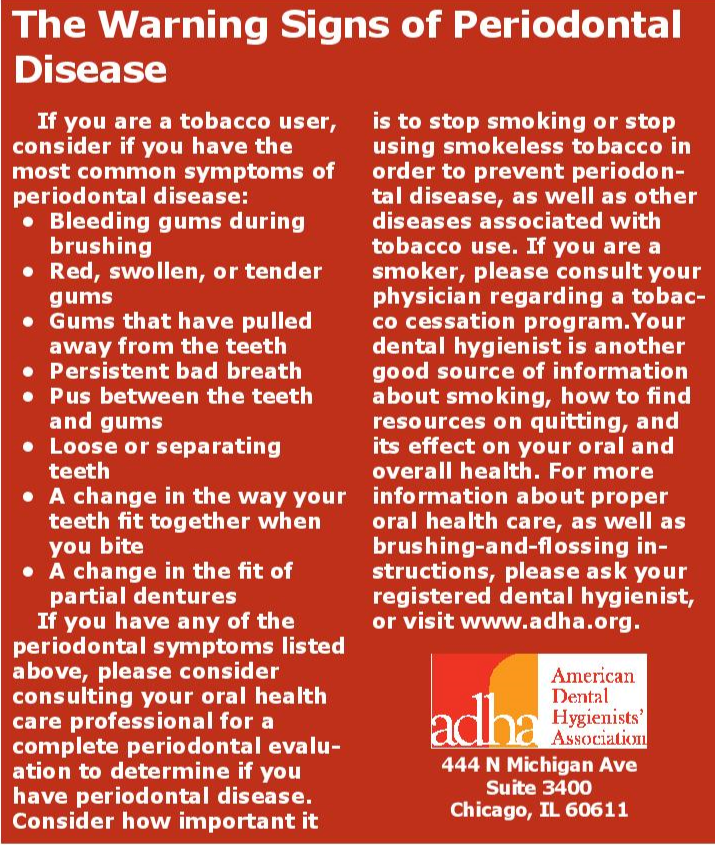As if the oral effects of bad breath, stained teeth, loss of taste and smell, mouth (canker) sores, failure of dental implants, and oral cancer weren’t enough, tobacco use is implicated in the gum recession, bone loss, and tooth loss associated with periodontal (gum) disease.
Smokers who smoked less than a half a pack of cigarettes per day are almost three times more likely than nonsmokers to have periodontitis, according to a study by researchers at the Centers for Disease Control and Prevention in Atlanta, Georgia. The same study found that those who smoked more than a pack and a half of cigarettes per day had almost six times the risk.
 Periodontal diseases, including gingivitis and periodontitis, are severe infections, and if left untreated, they can lead to tooth loss. Periodontal disease is a chronic bacterial infection that affects the gum tissue, bone, and attachment fibers that support the teeth and hold them in place in the jaw bone. It occurs when plaque (a soft, sticky, colorless film of bacteria) forms on the teeth and at the gumline and infects the gum tissue, causing gingivitis (inflammation and reddening of the gums). If periodontal disease is not treated with professional prophylaxis (teeth cleaning) and, in some cases, surgery, it can lead to moderate-to-advanced periodontitis and further destruction of the bone and gum tissue. Tooth loss may occur and teeth may have to be removed.
Periodontal diseases, including gingivitis and periodontitis, are severe infections, and if left untreated, they can lead to tooth loss. Periodontal disease is a chronic bacterial infection that affects the gum tissue, bone, and attachment fibers that support the teeth and hold them in place in the jaw bone. It occurs when plaque (a soft, sticky, colorless film of bacteria) forms on the teeth and at the gumline and infects the gum tissue, causing gingivitis (inflammation and reddening of the gums). If periodontal disease is not treated with professional prophylaxis (teeth cleaning) and, in some cases, surgery, it can lead to moderate-to-advanced periodontitis and further destruction of the bone and gum tissue. Tooth loss may occur and teeth may have to be removed.
Recent studies have shown that tobacco use in the form of cigarette, cigar, or pipe smoking,1 as well as smokeless tobacco use,2 are significant risk factors in the development and progression of periodontal disease. In turn, research links periodontal disease to increased risk of heart disease,3 stroke,4 poorly controlled diabetes,5 respiratory disease,6 and premature babies.7
Research shows that cigarette, cigar, and pipe smokers have a higher prevalence of moderate-to-severe periodontitis and higher prevalence and extent of attachment loss and gum recession than nonsmokers. They also have a higher number of missing teeth than nonsmokers; and although their gums bleed less, it is most often because nicotine constricts blood vessels, not because their gums are healthier. In addition, tobacco smokers are more likely than nonsmokers to have calculus (hardened or calcified dental plaque) formation on their teeth, to have developed periodontal pockets, to have lost bone that supports teeth, and to have lost supporting tissue that attaches the tooth to the bone.1
Tobacco use can also affect the success of periodontal treatment. Cigarette smoke contains over 4,800 chemicals, 69 of which are known to cause cancer. When a smoker lights a cigarette and inhales, these toxins are drawn into the lungs. From there, they enter the bloodstream, which delivers them to every cell throughout the body, which cannot defend itself from them. Smoking also reduces the delivery of oxygen and nutrients to the gingival tissue, and it interferes with healing and makes smokers less likely to respond to treatment, lengthening the time it takes for treatments to work.
Smokeless tobacco—tobacco or a tobacco blend that users chew, inhale, or suck rather than smoke—also contributes to gum disease. Studies have shown that about 7–27% of regular smokeless tobacco users have gum recession and may lose the bone around the teeth and experience tooth loss.8 In addition, smokeless tobacco causes leukoplakia,9 white patches that form on the site where the user holds the tobacco. Research has also linked chewing tobacco to dental caries (cavities).10
1. Albandar JM, Streckfus CF, Adesanya MR, Winn DM: Cigar pipe, and cigarette smoking as risk factors for periodontal disease and tooth loss. Journal of Periodontology 2000;71(12)1874-1881.
2. Tobacco use increases the risk of gum disease. Available at https://www.perio.org/consumer/smoking.htm.
3. Buhlin K, Gustafsson A, Ahnve S, et al.: Oral health in women with coronary heart disease. Journal of Periodontology 2005;76(4):544-550.
4. Scannapieco FA, Bush RB, Paju S: Associations between periodontal disease and risk for atherosclerosis, cardiovascular disease, and stroke. A systematic review. Annals of Periodontology 2003;8(1):38-53.
5. Campus G, Salem A, Uzzau S, et al.: Diabetes and periodontal disease: A case-control study. Journal of Periodontology 2005;76(3):418-425.
6. Scannapieco FA, Wang B, Shiau HJ: Oral bacteria and respiratory infection: Effects on respiratory pathogen adhesion and epithelial cell proinflammatory cytokine production. Annals of Periodontology 2001;6(1):78-86.
7. American Academy of Periodontology Statement Regarding Periodontal Management of the Pregnant Patient. Journal of Periodontology 2004;75(3):495-495.
8. American Cancer Society: Smokeless tobacco. Available at https://www.cancer.org/docroot/PED/content/PED_10_2x_Smokeless_Tobacco_and_Cancer.asp?sitearea=PED
9. Shulman JD, Beach MM, Rivera-Hidalgo F: The prevalence of oral mucosal lesions in U.S. adults: Data from the Third National Health and Nutrition Examination Survey, 1988-1994. Journal of the American Dental Association 2004;135:1279-1286.
10. Tomar SL, Winn DM: Chewing tobacco use and dental caries among U.S. men. Journal of the American Dental Association 1999;130(11):1601-1610.
